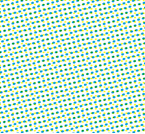SCREENS AND ROSETTES
METHODS OF SCREEN-TYPE PATTERN DISTINCTIVENESS REDUCTION
Formation of the rosette structure, or rosettes, significantly affects visual perception of the image. Very often, it is the formation of the rosette structure on the informationally critical areas of the image leads to groundless claims of clients.
The most intuitive method of reducing distinctiveness is to increase the lineature during screening. Indeed, increasing the lineature results in decrease of the halftone rosettes, but for example, as calculations show, the lineature increase from 150 to 175 lines per inch results in reduction of the rosette only by 11 percent, so this method is not very productive. And given the challenges posed by increasing the lineature for printing and loss of gradation, it is generally undesirable.
More effective methods are the techniques based on the destruction of the rosette structure. For example, changing the frequencies of the individual separations. But it requires caution and thorough check before industrial use.
Many raster processors offer ready screen-sets with changed separation frequencies, matched exactly with intention of reducing rosette structure in the image.

ANOTHER WAY OF HALFTONE ROSETTE DEGRADING IS TO SELECT THE COLOR SYNTHESIS METHOD.
VISUAL SIZE OF HALFTONE ROSSETTE VARIES DEPENDING ON DIFFERENET COLORS AND DEPENDS ON CMYK COORDINATES OF THE REPRODUCED COLOR.
Let us consider the influence of CMYK-formula on the halftone rosette formation
The figure shows the three types of halftone rosettes formed as a result of applying the “classic” screen rotation angles for the three options


1 - halftone rosette formed with two inks


2 - halftone rosette formed with three inks


3 - halftone rosette formed with four inks
As it is vividly seen in the figures, the more color contour paints (CCP) are involved in the formation of halftone rosette, the greater is its size. Consequently, it is necessary to choose the color separation methods, so that the colors formed at the color synthesis, especially in halftones, had optimal formula for the screen structure. For example, GCR with late start of black ink.
CERTAINLY, INTER-SEPARATION MOIRE CAN BE FULLY ELIMINATED, BUT USING OTHER METHODS
One of the most promising methods that can completely eliminate the formation of the interference patterns is to use stochastic screening. No periodic structure means no moire. Currently, there is an active standardization of printing using stochastic screens, so in the next 3-5 years, stochastics will be widely used in industrial printing, both in sheet and web printing.
Applying of the combined screening (not to be confused with the hybrid). The combined screening is the use of different types of screens for screening of various colorful separations.
EXAMPLE
To reduce the halftone rosette, the black ink can be derived by stochastics, and the cyan, magenta and yellow with the circular or elliptical dot with rotation angles of 15°, 45° and 75° respectively. In this embodiment, the value of the halftone rosette is almost equal to the lineature, and, therefore, it is visually indistinguishable under normal viewing conditions.


CLASSIC ELLIPTICAL SCREEN


COMBINED SCREENING
This screening method is completely fits in color the print standard and does not require special profiling of the process. One needs only to compensate the tone curve for the black ink.
Currently, the technique of combined screening on the existing raster processors is worked out in detail in the printing house of the Print House «Pushkinskaya Ploshchad», and it is applied very successfully at printing of a number of editions.
